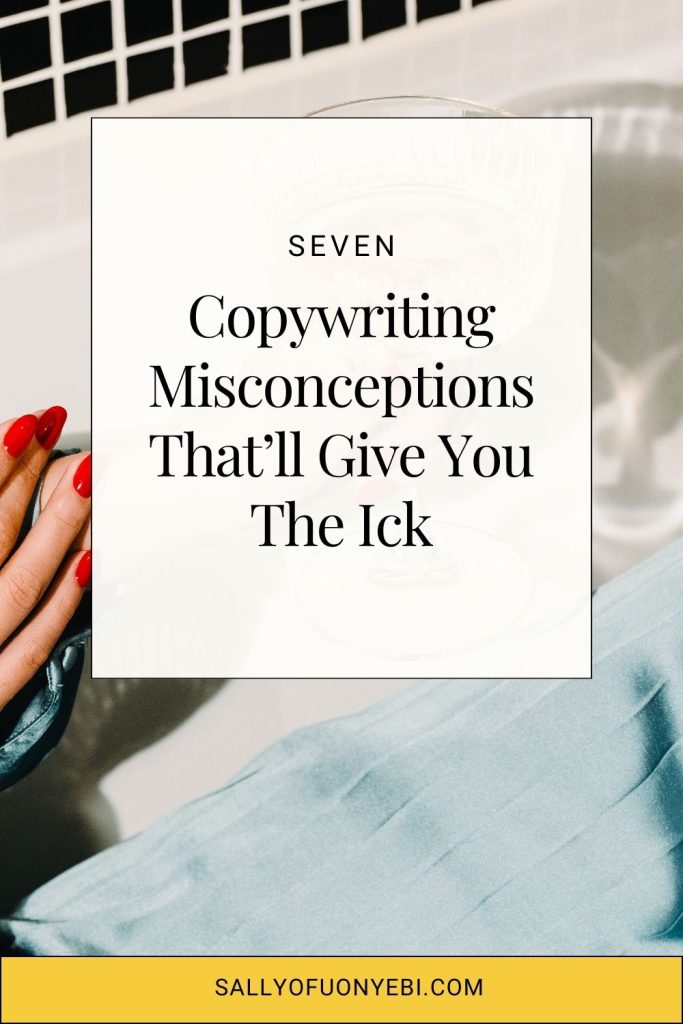
I grew up believing that “an apple a day keeps the doctor away” because my teacher always said it.
Maybe that’s why my dad always bought bowls upon bowls of green apples and pink ladies.
But eating apples every day didn’t save me from malaria or one embarrassing afternoon when diarrhea almost made me shit my pants in the presence of my dad’s guest. Because, let’s be honest, the “apple magic” belief is just a myth. A misconception I believed to be true.
Likewise, some copywriting myths have circulated in the marketing industry over the years. Now, everyone and their moms throw these statements around, but that doesn’t make them true. Many coaches and service-based creatives hold on to these misconceptions that are tanking their conversions and business growth.
In this guide, I debunk seven of the biggest ones flying around. You’ve heard them more times than you can count, and you need to avoid them like the plague.
1. One size fits all
Some business owners believe that if a piece of copy works for one occasion, it will work in any other scenario. This isn’t true.
When it comes to writing copy that converts, there isn’t a single, fixed approach. There are varying copywriting formulas. Although these formulas have the same overall concept, their approaches aren’t the same. Also, your copy can be long or short-form. And just because one type works for A doesn’t mean it will work for B.
For instance, it’s easy to sell a $47 product using short-form copy. But, you will need to make a hell of a convincing story when asking people to join your $6497 program.
2. Great copy always sells
This is another copywriting myth, and it is E-VERY-WHERE.
I know that my job as a copywriter is to create copy assets that’ll increase your conversions and sales. But, in full transparency, copy alone is not enough to guarantee sales. It’s the penultimate factor.
Do you know what the ultimate sales-determining factor is?
Your product.
No copywriting guru—regardless of the number of sales-magic hats they have or the 17 touchpoint checklists they make when writing copy—can save a bad or mediocre product.
If a client is dissatisfied, the White House Office of Consumer Affairs found that they will tell 9-15 people about their experience. Negative reviews spread like wildfire. So, put in the work and build a value-led offer that is exactly (maybe even more than) what you claim it is.
3. Focus on the juicy parts
“Emphasize benefits, not features.”
I bet you have heard this statement a hundred and one times (and, perhaps, 25 times out of that was from me)—and it’s true. But this isn’t a replacement for “addressing the challenges your ideal clients face.” People say you shouldn’t talk about your audience’s pain points because it’s negative marketing.
Truth bomb: Talking about pain points isn’t negative marketing if done right.
Pain-point marketing is, in fact, ethical. It’s okay to address your ideal client’s challenges because, a lot of times, people don’t even know they struggle with some unresolved problems that have caused neck-deep pain points in their lives and businesses.
By addressing these, you open their eyes to their reality and help them foresee a life that’s free of these pain points, and in doing so, you gain a brand positioning advantage.
4. Copy is expensive. It’s just writing, duh
Many creative ‘preneurs get it wrong here and thus miss out on the many good things copywriting can do for their businesses.
When you think copy is just writing, you become free to delegate your “conversion copywriting tasks” to your virtual assistant, blog writer, or social media manager, who still isn’t a copywriter.
But that’s not how you’ll get the results you desire. I know because so much goes into copywriting that not many people know about.
It is not just writing. It is research + sales psychology + creativity + writing + a lot of your personality.
Copy is not just “content.” More like “sales content,” yeah? It’s a messaging bridge that allows your ideal clients to cross from being bystanders to becoming paying clients. And when you hire a copywriter who can get you results (oh hey, that’s me), it’s never “expensive.” It’s an investment because you’ll get value for your money.
5. Selling isn’t about you
How many times have you heard that “people don’t care about you; they only care about what your offer can do for them?”
I’m betting it’s a lot more than you can keep track of. Now, that’s affecting how you market your offer because you believe you shouldn’t be talking about yourself.
The statement, “Selling isn’t about you,” helps you shift your message from being self-centered to audience-centric. It isn’t to banish your experience or brand story to the background.
For example, instead of saying, “I’m a copywriter who knows how to write words that sell. I’ve written copy that has gotten my clients $X.” You’re able to shift your message to, “You want to sell with your words, and that is precisely what I help you achieve. You, too, can get $X every time you launch, just like some of these other clients.”
But, hey—
Your ideal clients give plenty of sh*t about you. Plus, humans are drawn to backstories and crave a deeper connection that goes beyond your colorful “buy now” button.
So, selling is about you. Your experience. Your story. Your mission. Your values.
Start inserting yourself into their story. People will buy if they are in sync with your brand vibe. So, don’t be less of who you are because you think it’s cringeworthy, selfish, or boring. It’s not, I promise—and if you need someone to tell it for you, let’s work together.
6. “My niche doesn’t need copy”
I promise you NEED copy—and so do Felicia, Christine, and Annabelle. Every business does.
Copywriting for businesses doesn’t always have to be in the form of SEO website copy, sales pages, or launch sequences. There are many other ways creatives use copy to improve their businesses. Many of what you may not even refer to as “copy.”
Some of these copy assets include:
- product descriptions in e-commerce stores
- pre-launch social media content
- weekly newsletters to nurture subscribers
- sales emails for evergreen funnels
- scripts for YouTube and brand videos
- ad copy on social media
- micro-copy such as lead-gen popups, banners, and quick cool words in website footers
- copy for quiz funnels.
Whether you sell digital products, coaching programs, one-on-one services, or subscription-based offers, you need conversion copy.
7. A copywriter can read your audience’s minds
But, can we?
Nossir. We’re not psychic (even though sometimes I wish I were).
As a copywriter, what I do is create conversion-driven copy based on your (and my) research. So, it boils down to you knowing exactly who you’re trying to reach. Who is your ideal client?
And this goes beyond their gender or age range. You need to know what makes them “tick.” Their interests, main challenges, pain points, and desires.
I created the Ideal Client Handbook, complete with a Customer Voice Research Guide and an Ideal Client Development Workbook, to help you develop content and offers your audience will be thirsty for.
With this information, you can create bingeworthy copy that puts your brand at the forefront of their minds.
Avoid these 7 copywriting myths
You’re amazing at what you do, but does your brand copy reflect this? If not, let go of these copywriting misconceptions already. They’re holding you back from scaling your business.
The truth is, you need great copy that’ll stop your ideal clients in their tracks and get them to gush over the amazingness of what you offer.
Looking to collaborate with a copywriter who can make this happen for you? Let’s talk about your project.





